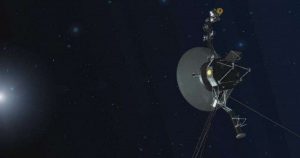
Voyager Spacecraft Setting Records Even After 40 Years By Reaching For The Stars
Forty years ago, a group led by astronomer Carl Sagan and his wife Ann Druyan curated the Golden Record, which was considered humanity’s message to space. The 12-inch, gold-plated copper disk contained 115 images and a variety of natural sounds made by the sea, wind and thunder, birds, whales, and other animals.
The record also contained music from different cultures and eras, as well as spoken greetings from people in 55 languages. The record (one disk for each of Voyager’s two space probes) is continuing on its way out of the solar system and serves as a kind of multimedia time capsule for any intelligent extraterrestrial life forms or future humans who may one day discover it.
Their story has not only impacted generations of current and future scientists and engineers, but also Earth’s culture, including film, art, and music. Each spacecraft carries a Golden Record of Earth sounds, pictures, and messages. Since the spacecraft could last billions of years, these circular time capsules could one day be the only traces of human civilization.

“I believe that few missions can ever match the achievements of the Voyager spacecraft during their four decades of exploration. They have educated us to the unknown wonders of the universe and truly inspired humanity to continue to explore our solar system and beyond,” said Thomas Zurbuchen, associate administrator for NASA’s Science Mission Directorate (SMD) at NASA Headquarters.
To celebrate the 40th anniversary of the Golden Record being sent into space, NASA is inviting space fans to send a short, positive message that could end up in space. After input from the Voyager team and a public vote, one of the submitted messages will be selected by NASA to “beam into interstellar space” on Sept. 5, the 40th anniversary of Voyager 1’s launch.
The Voyagers have set numerous records in their unparalleled journeys. In 2012, Voyager 1, which launched on Sept. 5, 1977, became the only spacecraft to have entered interstellar space. Voyager 2, launched on Aug. 20, 1977, is the only spacecraft to have flown by all four outer planets Jupiter, Saturn, Uranus, and Neptune.
Though the spacecraft has left the planets far behind and neither will come remotely close to another star for 40,000 years the two probes still send back observations about conditions where our Sun’s influence diminishes and interstellar space begins. Voyager 1, now almost 13 billion miles from Earth, travels through interstellar space northward out of the plane of the planets.
Voyager 1 also hinted that the magnetic field of the local interstellar medium is wrapped around the heliosphere. Voyager 2, now almost 11 billion miles from Earth, travels south and is expected to enter interstellar space in the next few years. The different locations of the two Voyagers allow scientists to compare right now two regions of space where the heliosphere interacts with the surrounding interstellar medium using instruments that measure charged particles, magnetic fields, low-frequency radio waves and solar wind plasma.
“None of us knew, when we launched 40 years ago, that anything would still be working, and be continuing on this pioneering journey,” said Ed Stone, Voyager project scientist based at Caltech in Pasadena, California. “The most exciting thing they find in the next five years is likely to be something that we didn’t know was out there to be discovered.”

Each Voyager has three radioisotope thermoelectric generators, devices that use the heat energy generated by the decay of plutonium-238 only half of it will be gone after 88 years. Space is almost empty, so the Voyagers are not at a significant level of risk of bombardment by large objects. However, Voyager 1’s interstellar space environment is not a complete void. It’s filled with clouds of dilute material remaining from stars that exploded as supernovae millions of years ago.
“The technology is many generations old, and it takes someone with 1970s design experience to understand how the spacecraft operate and what updates can be made to permit them to continue operating today and into the future,” said Suzanne Dodd, Voyager project manager based at NASA’s Jet Propulsion Laboratory in Pasadena. Team members estimate they will have to turn off the last science instrument by 2030.
However, even after the spacecraft go silent, they’ll continue on their trajectories at their present speed of more than 30,000 mph (48,280 kilometers per hour), completing an orbit within the Milky Way every 225 million years.